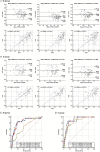Diagnostic accuracy of quantitative flow ratio (QFR) and vessel fractional flow reserve (vFFR) estimated retrospectively by conventional radiation saving X-ray angiography
- PMID: 33454897
- PMCID: PMC8105229
- DOI: 10.1007/s10554-020-02133-8
Diagnostic accuracy of quantitative flow ratio (QFR) and vessel fractional flow reserve (vFFR) estimated retrospectively by conventional radiation saving X-ray angiography
Abstract
Background: Angiography derived FFR reveals good performance in assessing intermediate coronary stenosis. However, its performance under contemporary low X-ray frame and pulse rate settings is unknown. We aim to validate the feasibility and performance of quantitative flow ratio (QFR) and vessel fractional flow reserve (vFFR) under such angiograms.
Methods: This was an observational, retrospective, single center cohort study. 134 vessels in 102 patients, with angiograms acquired under 7.5fps and 7pps mode, were enrolled. QFR (fQFR and cQFR) and vFFR were validated with FFR as the gold standard. A conventional manual and a newly developed algorithmic exclusion method (M and A group) were both evaluated for identification of poor-quality angiograms.
Results: Good agreement between QFR/vFFR and FFR were observed in both M and A group, except for vFFR in the M group. The correlation coefficients between fQFR/cQFR/vFFR and FFR were 0.6242, 0.5888, 0.4089 in the M group, with rvFFR significantly lower than rfQFR (p = 0.0303), and 0.7055, 0.6793, 0.5664 in the A group, respectively. AUCs of detecting lesions with FFR ≤ 0.80 were 0.852 (95% CI 0.722-0.913), 0.858 (95% CI 0.778-0.917), 0.682 (95% CI 0.586-0.768), for fQFR/cQFR/vFFR in the M group, while vFFR performed poorer than fQFR (p = 0.0063) and cQFR (p = 0.0054). AUCs were 0.898 (95% CI 0.811-0.945), 0.892 (95% CI 0.803-0.949), 0.843 (95% CI 0.746-0.914) for fQFR/cQFR/vFFR in the A group. AUCvFFR was significantly higher in the A group than that in the M group (p = 0.0399).
Conclusions: QFR/vFFR assessment is feasible under 7.5fps and 7pps angiography, where cQFR showed no advantage compared to fQFR. Our newly developed algorithmic exclusion method could be a better method of selecting angiograms with adequate quality for angiography derived FFR assessment.
Keywords: Angiography; Fractional flow reserve; QFR; vFFR.
Conflict of interest statement
All the authors have no conflict in relation to this study.
Figures





References
-
- Siebert U, Arvandi M, Gothe RM, et al. Improving the quality of percutaneous revascularisation in patients with multivessel disease in Australia: cost-effectiveness, public health implications, and budget impact of FFR-guided PCI. Heart Lung Circ. 2014;23(6):527–533. doi: 10.1016/j.hlc.2013.12.009. - DOI - PubMed
-
- Levine GN, Bates ER, Blankenship JC, et al. 2011 ACCF/AHA/SCAI Guideline for Percutaneous Coronary Intervention: executive summary: a report of the American College of Cardiology Foundation/American Heart Association Task Force on Practice Guidelines and the Society for Cardiovascular Angiography and Interventions. Circulation. 2011;124(23):2574–2609. doi: 10.1161/CIR.0b013e31823a5596. - DOI - PubMed
Publication types
MeSH terms
Grants and funding
LinkOut - more resources
Full Text Sources
Other Literature Sources

